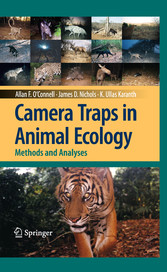Suchen und Finden
Camera Traps in Animal Ecology - Methods and Analyses
Remote photography and infrared sensors are widely used in the sampling of wildlife populations worldwide, especially for cryptic or elusive species. Guiding the practitioner through the entire process of using camera traps, this book is the first to compile state-of-the-art sampling techniques for the purpose of conducting high-quality science or effective management. Chapters on the evaluation of equipment, field sampling designs, and data analysis methods provide a coherent framework for making inferences about the abundance, species richness, and occupancy of sampled animals. The volume introduces new models that will revolutionize use of camera data to estimate population density, such as the newly developed spatial capture-recapture models. It also includes richly detailed case studies of camera trap work on some of the world's most charismatic, elusive, and endangered wildlife species. Indispensible to wildlife conservationists, ecologists, biologists, and conservation agencies around the world, the text provides a thorough review of the subject as well as a forecast for the use of remote photography in natural resource conservation over the next few decades.
Allan O'Connell is a research wildlife biologist with the U.S. Geological Survey's Patuxent Wildlife Research Center in Maryland. His research concentrates on wildlife management issues for U.S. federal resource agencies. His cutting-edge work includes the design of multiple technique sampling and monitoring programs to assess biodiversity, the use of camera traps to estimate population parameters, and the investigation of effects of predators on isolated populations of endangered species.
James Nichols is a senior scientist with the Patuxent Wildlife Research Center. He is an expert on capture-recapture sampling methods, population modeling, and adaptive management. He has authored or co-authored more than 350 scientific publications, including two books, four edited volumes, and nine monographs, on various aspects of wildlife population ecology. He is a recipient of the 2007 U.S. Presidential Rank Award for Meritorious Service and has received national recognition for his work from various universities, the U.S. Fish and Wildlife Service, U.S. Geological Survey, The Wildlife Society, American Statistical Association, and the U.S. Forest Service.
Ullas Karanth is an internationally known conservation scientist (see www.wikipedia.org). Based in India, he is a senior conservation scientist for the Wildlife Conservation Society, where his long-term research has focused on the ecology and conservation of tigers and their prey. He has more than 70 scientific publications to his credit. His work has been featured in the world's media including the New York Times, Time magazine, National Geographic, BBC, CNN, Discovery, and others. He is the recipient of the Sierra Club's prestigious international EarthCare Award and the World Wildlife Fund's J. Paul Getty Award for Conservation Leadership.
Alle Preise verstehen sich inklusive der gesetzlichen MwSt.







